Joey Harrington

Despite being on the cover of a video game (NCAA Football 2003), Joey Harrington couldn't make his college success carry over to the NFL. He led an impressive four-year career at Oregon, where Harrington threw for 6,911 yards and 59 touchdowns and compiled a 25-3 record (including bowl games), and then he became eligible for the 2002 NFL Draft. He was taken third overall by the Detroit Lions in the 2002 Draft, in what essentially marked the high point of his NFL career. According to Harrington, the four seasons he spent in Detroit were the worst of his life and made him resent football. Detroit certainly does have a way with people.
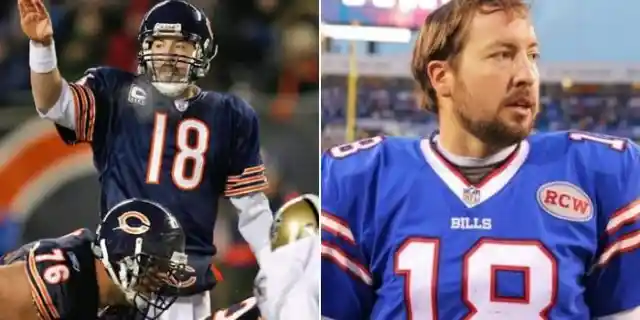
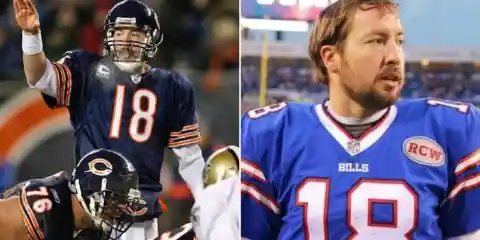

Despite being on the cover of a video game (NCAA Football 2003), Joey Harrington couldn't make his college success carry over to the NFL. He led an impressive four-year career at Oregon, where Harrington threw for 6,911 yards and 59 touchdowns and compiled a 25-3 record (including bowl games), and then he became eligible for the 2002 NFL Draft. He was taken third overall by the Detroit Lions in the 2002 Draft, in what essentially marked the high point of his NFL career. According to Harrington, the four seasons he spent in Detroit were the worst of his life and made him resent football. Detroit certainly does have a way with people.
Byron Leftwich

Byron Leftwich had an unbelievable career at Marshall and is widely remembered for finishing a drive with a broken shin bone in a comeback pinch against Akron. Injuries, however, would be a common theme that dogged the quarterback throughout his NFL tenure. At Marshall, Leftwich threw for 11,903 yards and 89 touchdowns, with just 28 interceptions. He was the MVP of the 2000 Music City Bowl. Leftwich was taken seventh overall in the 2003 NFL Draft by the Jacksonville Jaguars. He lasted four seasons there, but was never able to play a full season due to various injuries. Following his departure from the Jags, he bounced around to several teams, including Pittsburgh, where he won a Super Bowl ring as a backup to Ben Roethlisberger in 2009.
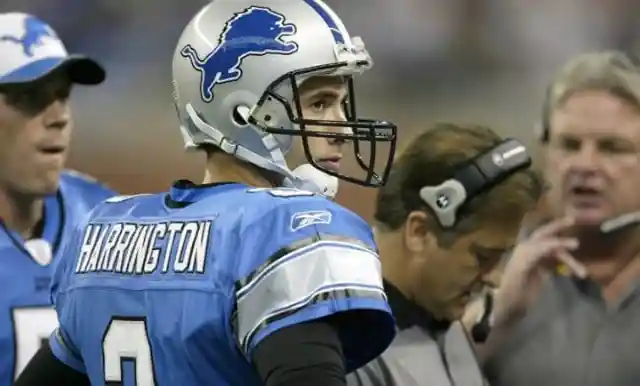
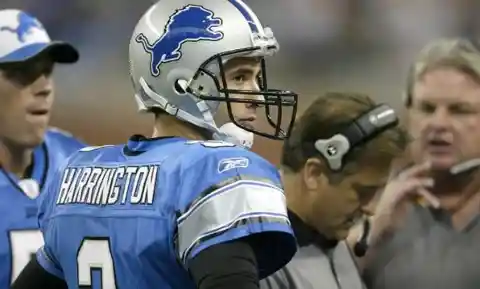

Byron Leftwich had an unbelievable career at Marshall and is widely remembered for finishing a drive with a broken shin bone in a comeback pinch against Akron. Injuries, however, would be a common theme that dogged the quarterback throughout his NFL tenure. At Marshall, Leftwich threw for 11,903 yards and 89 touchdowns, with just 28 interceptions. He was the MVP of the 2000 Music City Bowl. Leftwich was taken seventh overall in the 2003 NFL Draft by the Jacksonville Jaguars. He lasted four seasons there, but was never able to play a full season due to various injuries. Following his departure from the Jags, he bounced around to several teams, including Pittsburgh, where he won a Super Bowl ring as a backup to Ben Roethlisberger in 2009.
Brady Quinn

Brady Quinn was one of the most talked about Quarterbacks coming out of college, but his NFL career never got off the ground. After leaving Notre Dame as one of the school’s most decorated players in history, the Cleveland Browns elected to take the polished Quinn with the 22nd overall pick in the 2007 NFL Draft. Quinn, however, would only last three seasons quarterbacking the Browns before moving on to four other teams. Throughout his seven-year career, Quinn never started more than nine games in a season and only threw for 12 touchdowns, compared with his 17 interceptions. His professional career was a drastic contrast from the success he found at the college level.
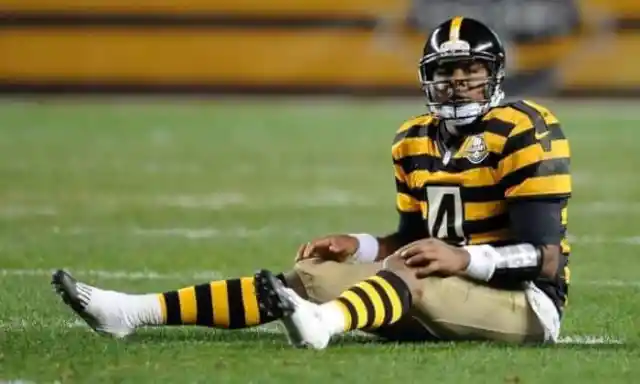
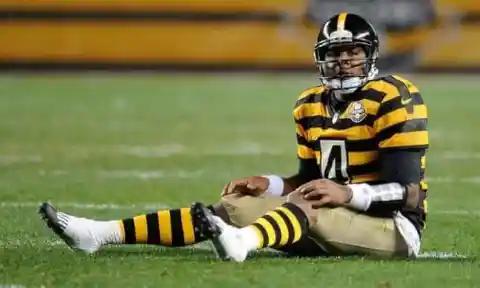

Brady Quinn was one of the most talked about Quarterbacks coming out of college, but his NFL career never got off the ground. After leaving Notre Dame as one of the school’s most decorated players in history, the Cleveland Browns elected to take the polished Quinn with the 22nd overall pick in the 2007 NFL Draft. Quinn, however, would only last three seasons quarterbacking the Browns before moving on to four other teams. Throughout his seven-year career, Quinn never started more than nine games in a season and only threw for 12 touchdowns, compared with his 17 interceptions. His professional career was a drastic contrast from the success he found at the college level.
Marc Bulger

Marc Bulger’s rise to NFL stardom was as remarkable as it was unexpected. He was drafted in the sixth round out of West Virginia by the Saints in 2000, but was waived before the season. He then signed with Atlanta as a practice squad player before being waived again. Finally, Bulger found a home in St. Louis, beginning as a practice squad player before being promoted to backup. Eventually, thanks to a rash of injuries, Bulger found his way into the starting lineup. Bulger would retain the starting job and lead the Rams into the playoffs on two occasions while being named to two Pro Bowl teams. Bulger would also become the fastest quarterback in NFL history to reach 1,000 completions. His impressive numbers earned the former backup a new contract that made him the highest-paid player in Rams history.
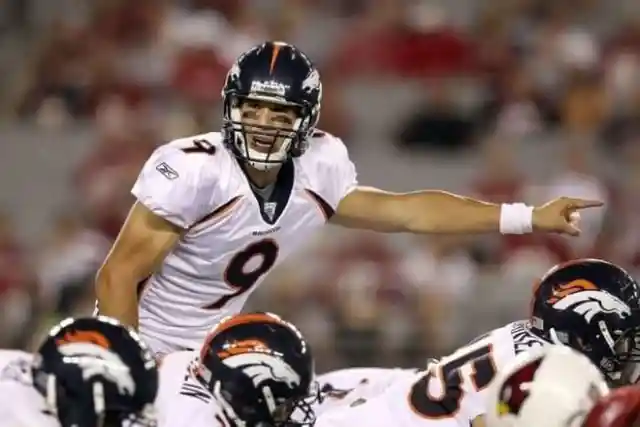
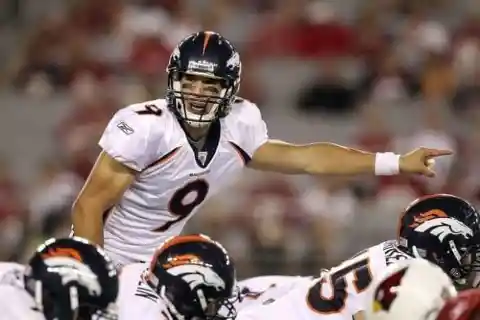

Marc Bulger’s rise to NFL stardom was as remarkable as it was unexpected. He was drafted in the sixth round out of West Virginia by the Saints in 2000, but was waived before the season. He then signed with Atlanta as a practice squad player before being waived again. Finally, Bulger found a home in St. Louis, beginning as a practice squad player before being promoted to backup. Eventually, thanks to a rash of injuries, Bulger found his way into the starting lineup. Bulger would retain the starting job and lead the Rams into the playoffs on two occasions while being named to two Pro Bowl teams. Bulger would also become the fastest quarterback in NFL history to reach 1,000 completions. His impressive numbers earned the former backup a new contract that made him the highest-paid player in Rams history.
David Garrard

David Garrard was one of the Jacksonville Jaguars’ only bright spots for a number of seasons. He captained the offense and was a Pro Bowler during the 2009 season. Drafted out of East Carolina University in the fourth round in the 2002, Garrard’s time as a starter came in spurts, beginning his career as the backup to Byron Leftwich (more on him later). Although the circumstances weren’t ideal, only finding playing time due to injury, Garrard was often able to showcase his talents thanks to the injury-prone Leftwich missing chunks of playing time season after season. Eventually, the starting job was given to Garrard. But he faced his own fair share of injuries playing behind an inept and decimated offensive line.
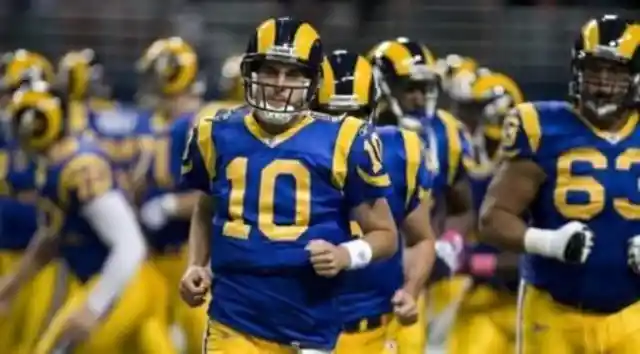
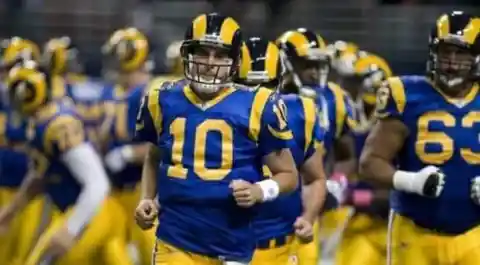

David Garrard was one of the Jacksonville Jaguars’ only bright spots for a number of seasons. He captained the offense and was a Pro Bowler during the 2009 season. Drafted out of East Carolina University in the fourth round in the 2002, Garrard’s time as a starter came in spurts, beginning his career as the backup to Byron Leftwich (more on him later). Although the circumstances weren’t ideal, only finding playing time due to injury, Garrard was often able to showcase his talents thanks to the injury-prone Leftwich missing chunks of playing time season after season. Eventually, the starting job was given to Garrard. But he faced his own fair share of injuries playing behind an inept and decimated offensive line.
Jason Campbell

The Washington Redskins have been a perennial dumpster fire representing the NFC East. They draft poorly, rotate coaches at an alarming rate, and are on the receiving end of criticism from many former players. So when the Redskins drafted Auburn quarterback Jason Campbell 25th overall in 2005, spirits were lifted. Management and fans thought they found their new franchise quarterback, a player who just led Auburn to a perfect season in of the SEC, capped with a Sugar Bowl victory over Virginia Tech. But Campbell, despite his best efforts, never managed to lead the Redskins to a winning record. Washington went 8-8 under Campbell in 2008 and 4-12 in 2009.
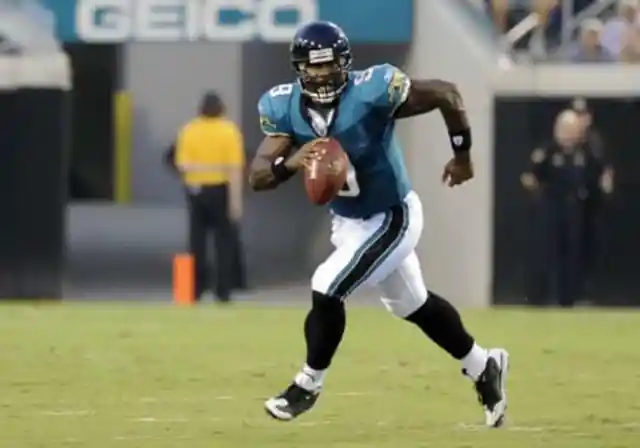
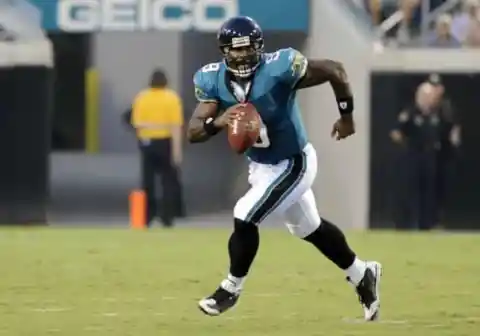

The Washington Redskins have been a perennial dumpster fire representing the NFC East. They draft poorly, rotate coaches at an alarming rate, and are on the receiving end of criticism from many former players. So when the Redskins drafted Auburn quarterback Jason Campbell 25th overall in 2005, spirits were lifted. Management and fans thought they found their new franchise quarterback, a player who just led Auburn to a perfect season in of the SEC, capped with a Sugar Bowl victory over Virginia Tech. But Campbell, despite his best efforts, never managed to lead the Redskins to a winning record. Washington went 8-8 under Campbell in 2008 and 4-12 in 2009.
Kyle Orton

He’s one of those players that you grow into hating, and you grow into it very quickly. His odd neck-beard and strange haircuts never helped him out. Neither did his inability to show emotion and take over games. Yet somehow, this quarterback lasted in the league for 10 years and was a consistent starter for multiple teams. Orton entered the league as a backup with the Chicago Bears in 2005, and got his chance to shine when starting quarterback Rex Grossman went down with an injury. Orton used this opportunity to jump-start his mediocre career. However, despite being a starter for numerous teams, Orton’s career never really amounted to anything significant.
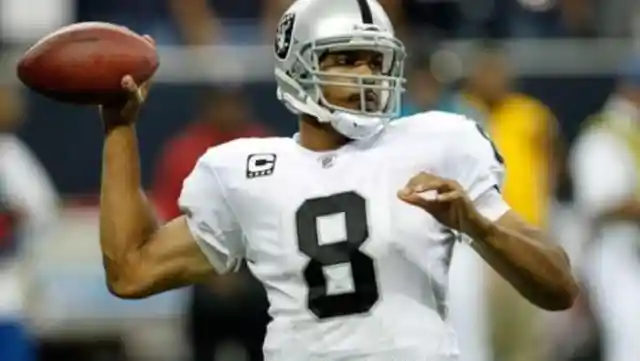
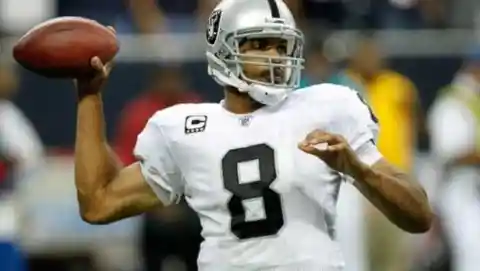

He’s one of those players that you grow into hating, and you grow into it very quickly. His odd neck-beard and strange haircuts never helped him out. Neither did his inability to show emotion and take over games. Yet somehow, this quarterback lasted in the league for 10 years and was a consistent starter for multiple teams. Orton entered the league as a backup with the Chicago Bears in 2005, and got his chance to shine when starting quarterback Rex Grossman went down with an injury. Orton used this opportunity to jump-start his mediocre career. However, despite being a starter for numerous teams, Orton’s career never really amounted to anything significant.
Jake Locker

Jake Locker’s NFL career should be called “The Hurt Locker,” for obvious reasons. The former eighth-overall pick in 2011 managed only four seasons in the NFL before injuries and a lack of passion took him away from the game he once loved. Widely considered a top talent at the University of Washington, the husky Locker amazed scouts with his intangibles and potential. The Titans, still reeling from their disappointing pick in Vince Young in 2006, jumped all over Locker. However, Locker would only start 23 out of 64 possible games over four seasons. A combination of upper and lower body injuries prevented the former college star from every really developing at the professional level. Eventually, the pain wasn’t worth the paycheck. Locker retired from the game following the 2014 season.
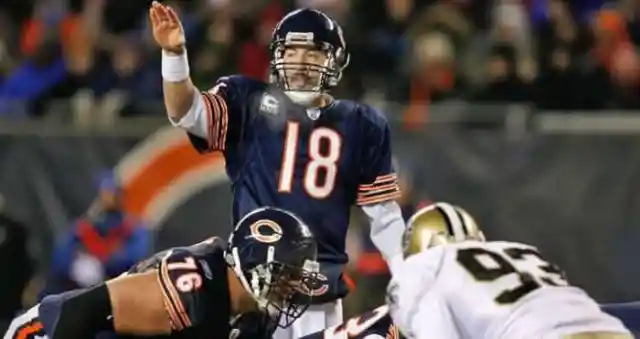
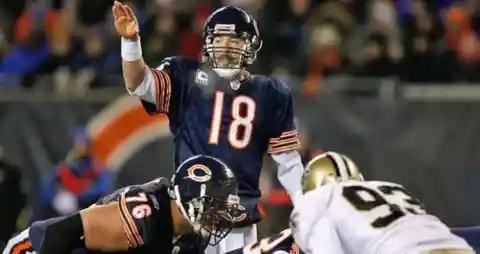

Jake Locker’s NFL career should be called “The Hurt Locker,” for obvious reasons. The former eighth-overall pick in 2011 managed only four seasons in the NFL before injuries and a lack of passion took him away from the game he once loved. Widely considered a top talent at the University of Washington, the husky Locker amazed scouts with his intangibles and potential. The Titans, still reeling from their disappointing pick in Vince Young in 2006, jumped all over Locker. However, Locker would only start 23 out of 64 possible games over four seasons. A combination of upper and lower body injuries prevented the former college star from every really developing at the professional level. Eventually, the pain wasn’t worth the paycheck. Locker retired from the game following the 2014 season.
Josh Freeman

When the Tampa Bay Buccaneers drafted Josh Freeman 17th overall out of Kansas State in 2009, they envisioned a quarterback who would lead their squad deep into the playoffs. They envisioned that the 6-foot-6, 240-pound behemoth of a quarterback would strike fear into opposing defenses every Sunday, beating teams with his arm and his legs. What they didn’t expect was a quarterback who would only last with the team for five seasons and play in the league for a total of seven. They didn’t envision Freeman falling so far off the map that he’d wind up with the Brooklyn Bolts of the Fall Experimental Football League. In his career, Freeman threw for 13,873 yards, 81 touchdowns and 68 interceptions.
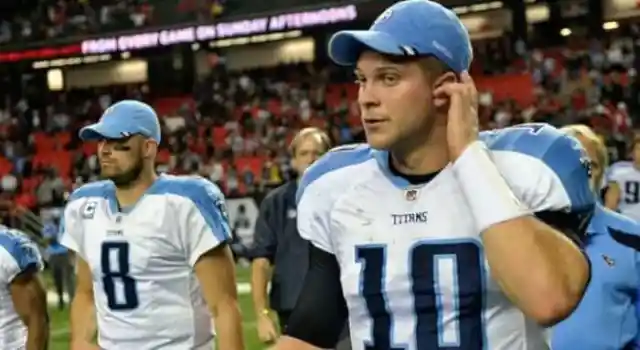
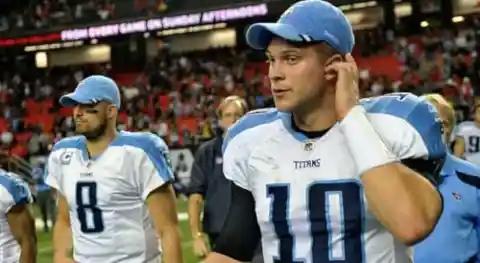

When the Tampa Bay Buccaneers drafted Josh Freeman 17th overall out of Kansas State in 2009, they envisioned a quarterback who would lead their squad deep into the playoffs. They envisioned that the 6-foot-6, 240-pound behemoth of a quarterback would strike fear into opposing defenses every Sunday, beating teams with his arm and his legs. What they didn’t expect was a quarterback who would only last with the team for five seasons and play in the league for a total of seven. They didn’t envision Freeman falling so far off the map that he’d wind up with the Brooklyn Bolts of the Fall Experimental Football League. In his career, Freeman threw for 13,873 yards, 81 touchdowns and 68 interceptions.
Daunte Culpepper

Injuries, injuries, injuries. They are a common theme here and have the ability to instantly set back and alter a career. Some players get lucky and have a successful rehabilitation that allows them to return to a high level of playing. Other players aren’t so lucky. For Daunte Culpepper, he fell somewhere in between the two extremes, although he decidedly wasn’t the same player following a devastating knee injury. The Vikings decided to take the UCF quarterback with the 11th pick in the 1999 NFL Draft. Culpepper, throwing to the great Randy Moss, would have some record-setting seasons as a Viking. He’d even be selected as the cover athlete for Madden 2002. However, with the honor of the Madden cover comes the Madden curse, and during the 2002 season Culpepper would see a drastic decline in his performance.
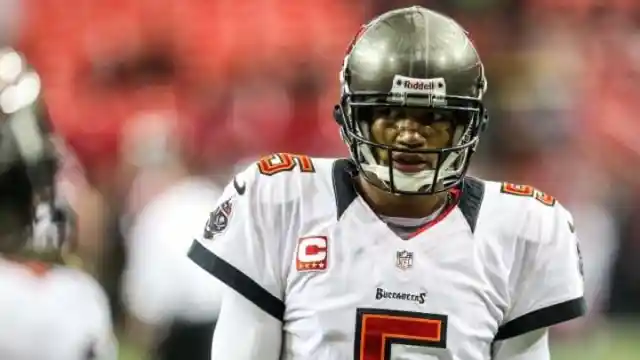
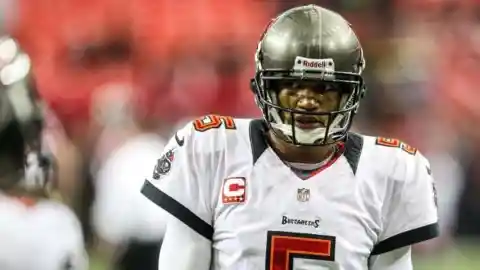

Injuries, injuries, injuries. They are a common theme here and have the ability to instantly set back and alter a career. Some players get lucky and have a successful rehabilitation that allows them to return to a high level of playing. Other players aren’t so lucky. For Daunte Culpepper, he fell somewhere in between the two extremes, although he decidedly wasn’t the same player following a devastating knee injury. The Vikings decided to take the UCF quarterback with the 11th pick in the 1999 NFL Draft. Culpepper, throwing to the great Randy Moss, would have some record-setting seasons as a Viking. He’d even be selected as the cover athlete for Madden 2002. However, with the honor of the Madden cover comes the Madden curse, and during the 2002 season Culpepper would see a drastic decline in his performance.
Tim Couch

When the Cleveland Browns re-entered the NFL as an expansion team in 1999, they were given the first pick in the NFL Draft. With it, they decided to address the quarterback position by selecting University of Kentucky product Tim Couch. As a college player at Kentucky, Couch threw for over 8,100 yards over his two seasons as a starter with 73 touchdowns. Couch is widely considered to be a massive bust, but the legitimacy of this claim can be questioned. He never had solid weapons around him, he was drafted to an expansion team that was building from scratch, and his offensive line was more porous than sandstone – a notoriously porous rock that arguably would have done a better job at blocking than his line.
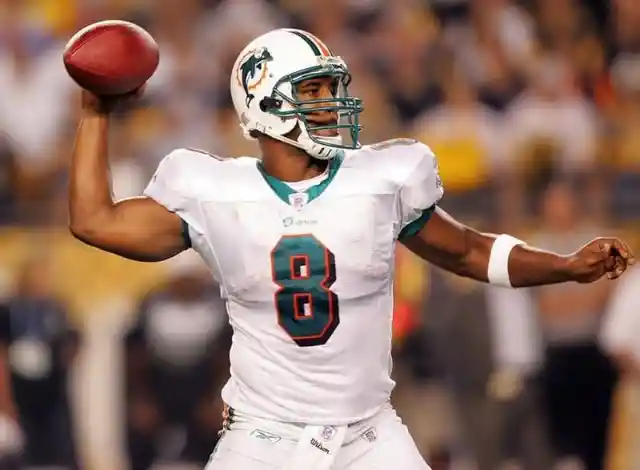
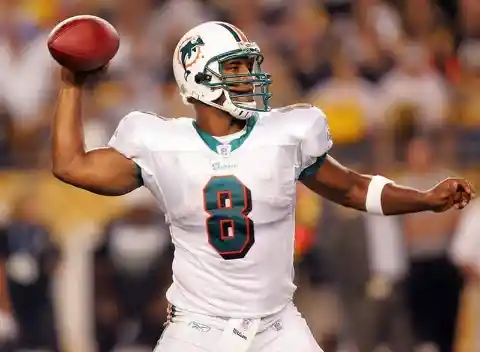

When the Cleveland Browns re-entered the NFL as an expansion team in 1999, they were given the first pick in the NFL Draft. With it, they decided to address the quarterback position by selecting University of Kentucky product Tim Couch. As a college player at Kentucky, Couch threw for over 8,100 yards over his two seasons as a starter with 73 touchdowns. Couch is widely considered to be a massive bust, but the legitimacy of this claim can be questioned. He never had solid weapons around him, he was drafted to an expansion team that was building from scratch, and his offensive line was more porous than sandstone – a notoriously porous rock that arguably would have done a better job at blocking than his line.
Rex Grossman

When the Indianapolis Colts defeated the Chicago Bears in Super Bowl XLI in January 2007, many people were gushing over Peyton Manning following his first Super Bowl victory. And a whole other group of people – mostly Chicago fans — detested the game for sloppy, rain-infused play and Bears QB Rex Grossman’s performance, including throwing a game-sealing interception. Grossman played six seasons for the Bears, only managing to play the full 16 games once. For his durability issues, he was given the name Rex Glassman. When the Bears finally decided to move on from their first-round project, Rex was a broken shell of himself. He signed with the Texans for one year and moved on to Washington after.
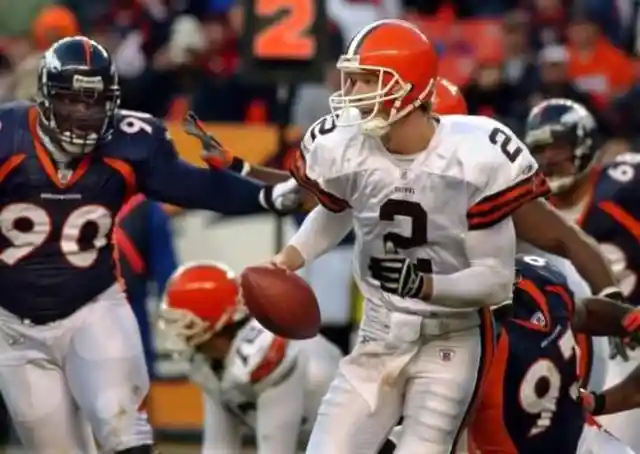
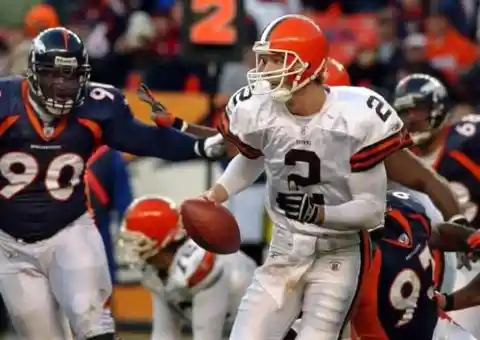

When the Indianapolis Colts defeated the Chicago Bears in Super Bowl XLI in January 2007, many people were gushing over Peyton Manning following his first Super Bowl victory. And a whole other group of people – mostly Chicago fans — detested the game for sloppy, rain-infused play and Bears QB Rex Grossman’s performance, including throwing a game-sealing interception. Grossman played six seasons for the Bears, only managing to play the full 16 games once. For his durability issues, he was given the name Rex Glassman. When the Bears finally decided to move on from their first-round project, Rex was a broken shell of himself. He signed with the Texans for one year and moved on to Washington after.
Jeff Garcia

Twelve seasons in the league, four Pro Bowls, and four playoff appearances. That’s not a bad resume, and for Jeff Garcia, these accolades make him one of the more accomplished players on this list. Most people remember Garcia for his time with the San Francisco 49ers, where he started for five seasons. Prior to his time in the Bay, Garcia was making a name for himself in the CFL, proving to NFL scouts that he had the talent and arm to succeed. Garcia’s time in San Fran was marked by both success and turmoil with star receiver Terrell Owens. One of Owens’ most famous remarks about Garcia’s sexuality was, “If it looks like a rat and smells like a rat, by golly it is a rat.” A statement like that succinctly reflects the type of relationship Owens had with QBs — sour, at best.
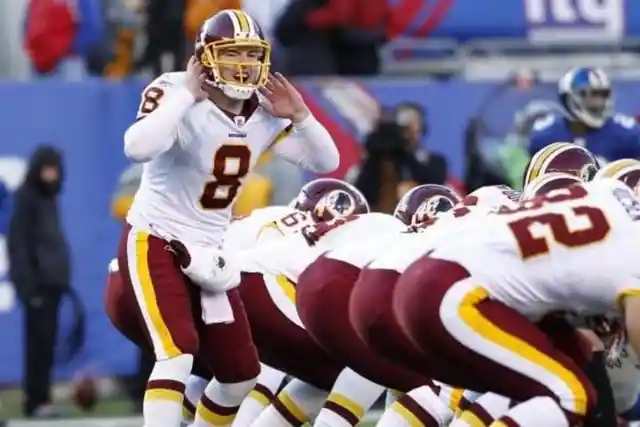
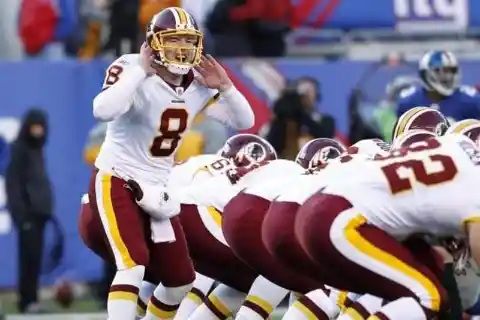

Twelve seasons in the league, four Pro Bowls, and four playoff appearances. That’s not a bad resume, and for Jeff Garcia, these accolades make him one of the more accomplished players on this list. Most people remember Garcia for his time with the San Francisco 49ers, where he started for five seasons. Prior to his time in the Bay, Garcia was making a name for himself in the CFL, proving to NFL scouts that he had the talent and arm to succeed. Garcia’s time in San Fran was marked by both success and turmoil with star receiver Terrell Owens. One of Owens’ most famous remarks about Garcia’s sexuality was, “If it looks like a rat and smells like a rat, by golly it is a rat.” A statement like that succinctly reflects the type of relationship Owens had with QBs — sour, at best.
Jeff George

The man had a nasty arm and an even nastier mullet. These two impressive forces, plus a decent college career at Illinois, where he threw for over 6,000 yards over two seasons, helped George become the No. 1 overall pick in the 1990 NFL draft, when the Indianapolis Colts gambled on the gunslinger. For a top overall pick, George’s NFL career was far from impressive. But he did manage to lead two separate teams into the playoffs. Despite flashes of success, George could never shake off his journeyman title – eight teams in 14 seasons — and only had four seasons where he started all 16 games.
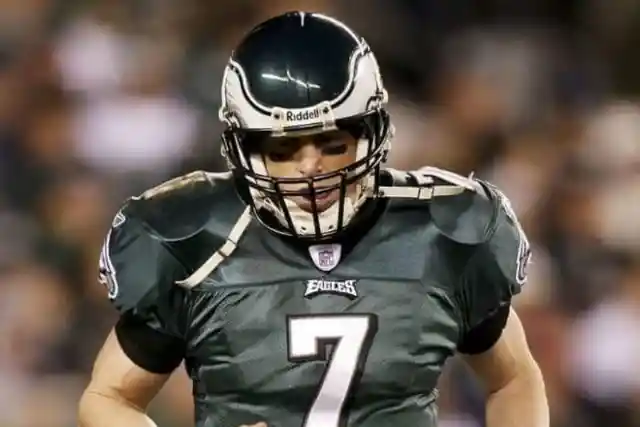
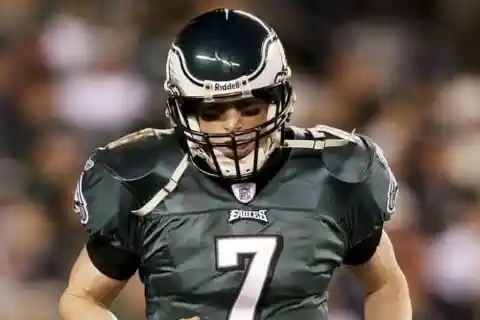

The man had a nasty arm and an even nastier mullet. These two impressive forces, plus a decent college career at Illinois, where he threw for over 6,000 yards over two seasons, helped George become the No. 1 overall pick in the 1990 NFL draft, when the Indianapolis Colts gambled on the gunslinger. For a top overall pick, George’s NFL career was far from impressive. But he did manage to lead two separate teams into the playoffs. Despite flashes of success, George could never shake off his journeyman title – eight teams in 14 seasons — and only had four seasons where he started all 16 games.
Christian Ponder

The 12th pick in the draft should, ideally, last longer than four seasons with the team. The player, in theory, should have multiple seasons starting all 16 games. Well, for the Vikings and Christian Ponder, this never translated to reality. Instead, Ponder would go down as one of the bigger draft busts in NFL history. An over-hyped quarterback coming out of Florida State in 2011, Ponder was pegged as the man who would right the Vikings’ ship. The problem was, he came into the league as a member of the notoriously weak draft, from a quarterback standpoint. Jake Locker, Blaine Gabbert, and Ponder all were featured in this draft, in the first round no less, and all of them struggled mightily.
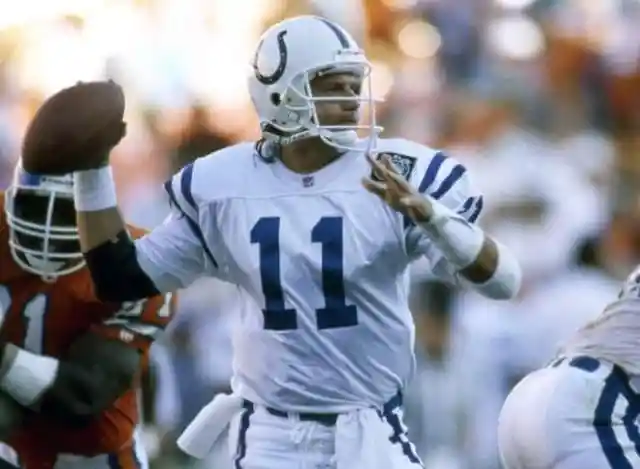
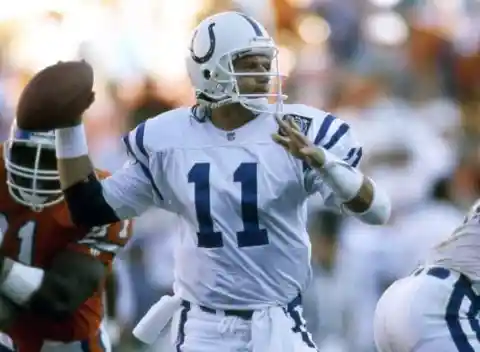

The 12th pick in the draft should, ideally, last longer than four seasons with the team. The player, in theory, should have multiple seasons starting all 16 games. Well, for the Vikings and Christian Ponder, this never translated to reality. Instead, Ponder would go down as one of the bigger draft busts in NFL history. An over-hyped quarterback coming out of Florida State in 2011, Ponder was pegged as the man who would right the Vikings’ ship. The problem was, he came into the league as a member of the notoriously weak draft, from a quarterback standpoint. Jake Locker, Blaine Gabbert, and Ponder all were featured in this draft, in the first round no less, and all of them struggled mightily.
Jon Kitna

It wasn’t always pretty – sometimes it was downright ugly – but quarterback Jon Kitna endured quite a long NFL career. Part of what made Kitna’s NFL journey so unique was that, coming out of Central Washington, he went undrafted in 1996. As a college player, Kitna threw for 12,353 yards and 99 touchdowns, but it wasn’t enough to get him on NFL Draft boards. Instead, Kitna went the undrafted free agent route, and after making the Seattle Seahawks practice squad and earning MVP honors in the NFL Europe, Kitna slowly worked his way up from backup to a starting role by 1999. Not only did Kitna work his way up from undrafted to starter, he finished the season with a winning record.
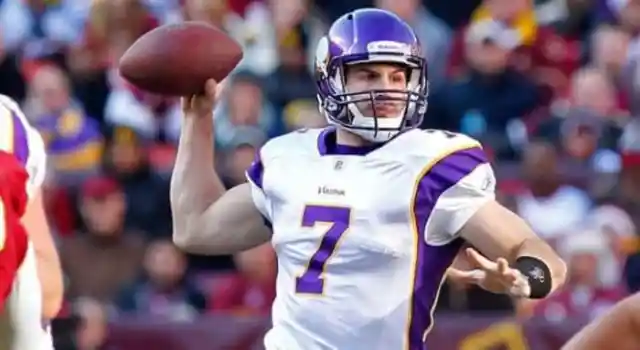
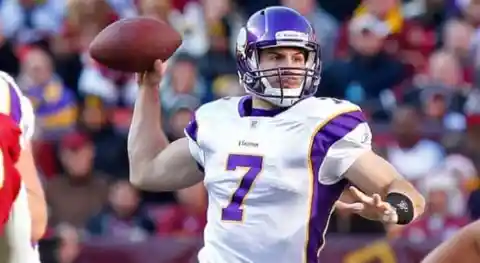

It wasn’t always pretty – sometimes it was downright ugly – but quarterback Jon Kitna endured quite a long NFL career. Part of what made Kitna’s NFL journey so unique was that, coming out of Central Washington, he went undrafted in 1996. As a college player, Kitna threw for 12,353 yards and 99 touchdowns, but it wasn’t enough to get him on NFL Draft boards. Instead, Kitna went the undrafted free agent route, and after making the Seattle Seahawks practice squad and earning MVP honors in the NFL Europe, Kitna slowly worked his way up from backup to a starting role by 1999. Not only did Kitna work his way up from undrafted to starter, he finished the season with a winning record.
Chad Pennington

Oh, what could have been. Chad Pennington was an outstanding quarterback at Marshall University and an all-around athlete who simply couldn’t do one critical thing – stay healthy. From 2000-08, Pennington flashed signs of greatness with the New York Jets and Miami Dolphins, but because of injuries, that’s all we ever got. Pennington first took over as the Jets starting quarterback in 2002, turning around a team that started the season 1-4 and leading them into the playoffs with a 9-7 record. The following season, Pennington suffered a rotator cuff injury, which required surgery twice, as it was re-injured the following season.
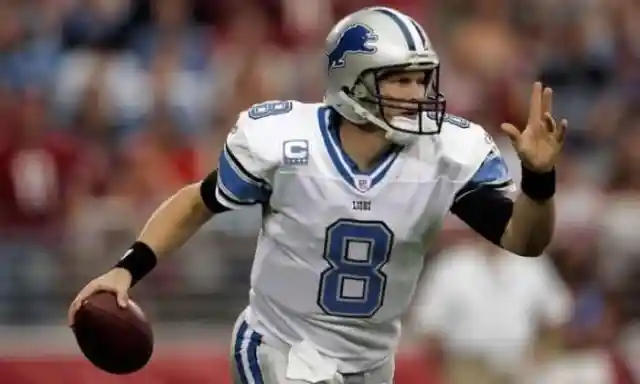
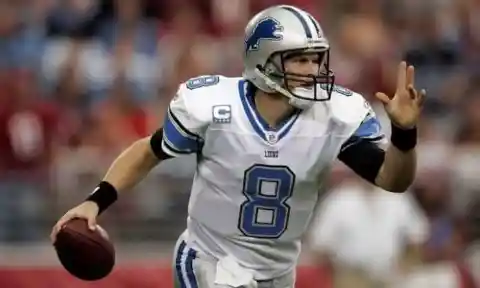

Oh, what could have been. Chad Pennington was an outstanding quarterback at Marshall University and an all-around athlete who simply couldn’t do one critical thing – stay healthy. From 2000-08, Pennington flashed signs of greatness with the New York Jets and Miami Dolphins, but because of injuries, that’s all we ever got. Pennington first took over as the Jets starting quarterback in 2002, turning around a team that started the season 1-4 and leading them into the playoffs with a 9-7 record. The following season, Pennington suffered a rotator cuff injury, which required surgery twice, as it was re-injured the following season.
David Carr

The Raiders have a real star in quarterback Derek Carr, but before his name was ever even appeared on NFL scouts’ radar, there was his older brother, David Carr. Coming out of Fresno State (like his younger brother), Carr was a hot commodity. In two years as the Bulldogs’ starter, David threw for 7,175 yards and 64 touchdowns. Expectations of Carr were sky high entering the 2002 NFL Draft. The NFL’s brand new expansion team, the Houston Texans, used the No. 1 overall pick to select Carr as their quarterback of the future. The Texans kicked off their first game in franchise history with a bang, taking down their fellow Texas team, the Dallas Cowboys, 19-10 at home. That was about as good as it got for Carr’s rookie season, as the Texans finished 4-12.
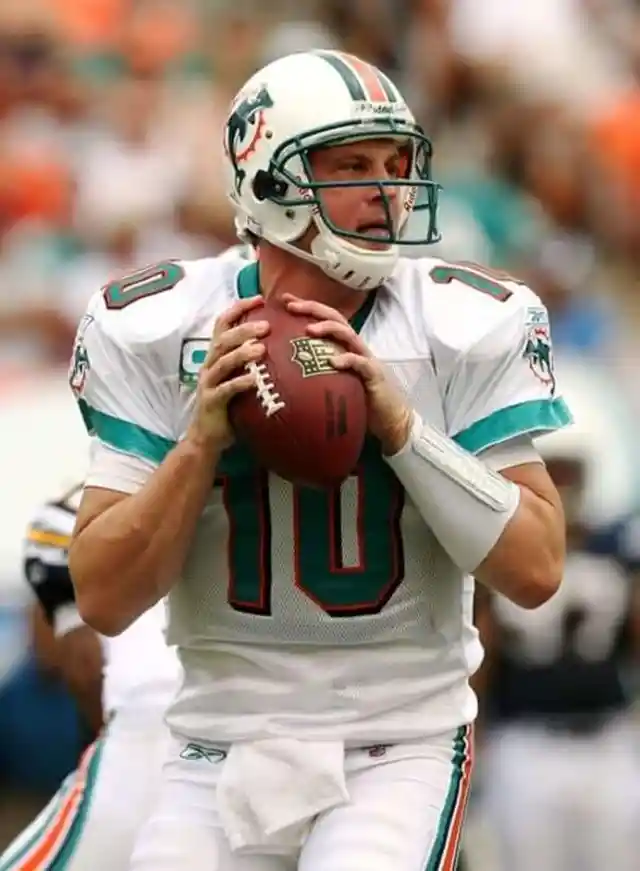
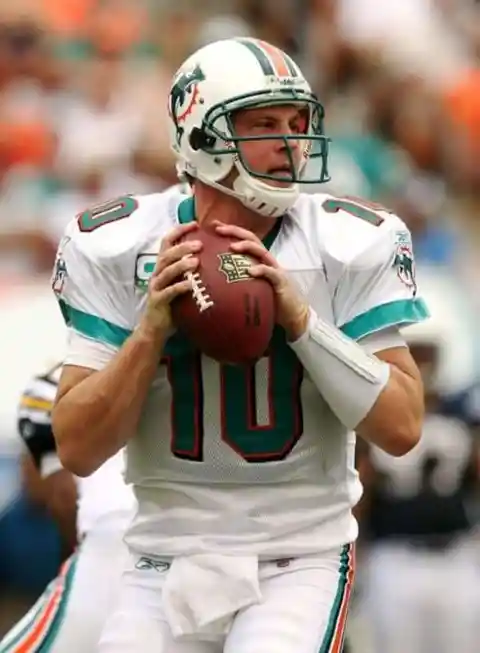

The Raiders have a real star in quarterback Derek Carr, but before his name was ever even appeared on NFL scouts’ radar, there was his older brother, David Carr. Coming out of Fresno State (like his younger brother), Carr was a hot commodity. In two years as the Bulldogs’ starter, David threw for 7,175 yards and 64 touchdowns. Expectations of Carr were sky high entering the 2002 NFL Draft. The NFL’s brand new expansion team, the Houston Texans, used the No. 1 overall pick to select Carr as their quarterback of the future. The Texans kicked off their first game in franchise history with a bang, taking down their fellow Texas team, the Dallas Cowboys, 19-10 at home. That was about as good as it got for Carr’s rookie season, as the Texans finished 4-12.
Jared Lorenzen

The Hefty Lefty. Jared Lorenzen is one of the largest quarterbacks in NFL history. He looked more like a center than the guy receiving snaps from the center. Lorenzen spent his playing career battling his weight as much as opponent defenders, and struggled with both before finally hanging up his cleats for good. Lorenzen dominated at Kentucky and broke numerous school records, but when the time came to jump to the professional level, the 330-pound left-hander wasn’t able to find success. Although he won a Super Bowl as a backup to Eli Manning, he completed only four total passes in his career. Lorenzen then left the NFL and tried to rejuvenate his career in semi-pro leagues before officially retiring in 2013.
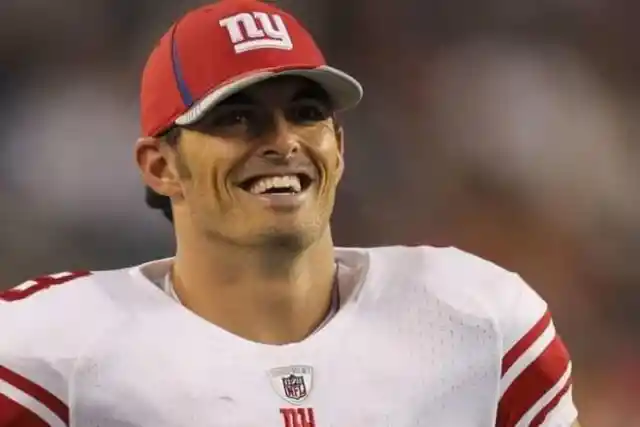
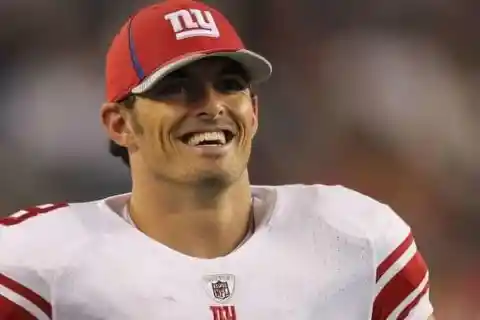

The Hefty Lefty. Jared Lorenzen is one of the largest quarterbacks in NFL history. He looked more like a center than the guy receiving snaps from the center. Lorenzen spent his playing career battling his weight as much as opponent defenders, and struggled with both before finally hanging up his cleats for good. Lorenzen dominated at Kentucky and broke numerous school records, but when the time came to jump to the professional level, the 330-pound left-hander wasn’t able to find success. Although he won a Super Bowl as a backup to Eli Manning, he completed only four total passes in his career. Lorenzen then left the NFL and tried to rejuvenate his career in semi-pro leagues before officially retiring in 2013.
Vinny Testaverde

When talking about tough guys, Vinny Testaverde is a true iron man. After an incredible college career with the Miami Hurricanes, nearly culminating with a national championship, Testaverde was selected No. 1 overall by the Tampa Bay Buccaneers in the 1987 NFL Draft, kicking off a professional career that defied time.Testaverde played for seven teams spanning an unfathomable 21 years! It wasn’t until his 10th year in the league at 33 years old that the veteran QB earned his first Pro Bowl selection during his first year with the Baltimore Ravens. Two years after his first Pro Bowl, Testaverde earned a second selection during his first year with the New York Jets in 1998, leading Gang Green to the AFC Championship game.
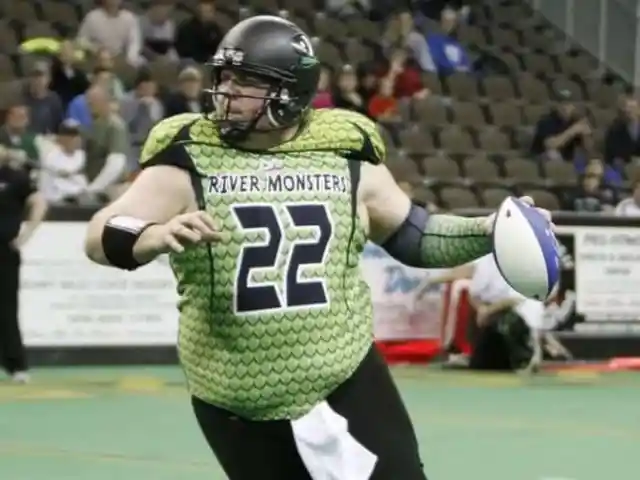
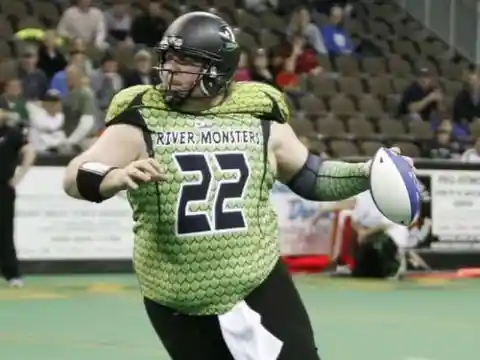

When talking about tough guys, Vinny Testaverde is a true iron man. After an incredible college career with the Miami Hurricanes, nearly culminating with a national championship, Testaverde was selected No. 1 overall by the Tampa Bay Buccaneers in the 1987 NFL Draft, kicking off a professional career that defied time.Testaverde played for seven teams spanning an unfathomable 21 years! It wasn’t until his 10th year in the league at 33 years old that the veteran QB earned his first Pro Bowl selection during his first year with the Baltimore Ravens. Two years after his first Pro Bowl, Testaverde earned a second selection during his first year with the New York Jets in 1998, leading Gang Green to the AFC Championship game.